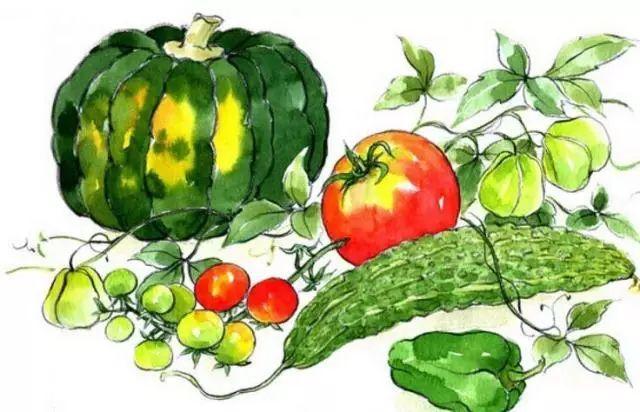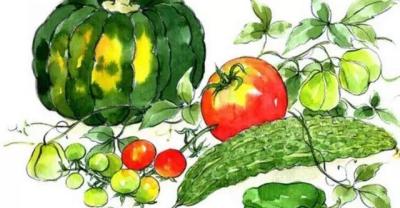Eat vegetables strategy, eat all kinds of vegetables in 2018!

According to their structure and edible parts, vegetables can be divided into leafy vegetables, rhizomes, melons and eggplants and fresh beans.
Vegetables are the main source of vitamins and minerals. In addition, it also contains more cellulose, pectin and organic acids, which can stimulate gastrointestinal peristalsis and the secretion of digestive juices, so they can also promote people's appetite and help digestion. The final metabolite of vegetables in the body is alkaline, so it is called "alkaline food", which plays an important role in maintaining acid-base balance in the body.
Leafy vegetables
Good source of dietary fiber
Cabbage, spinach, rape, leek, amaranth, etc., are good sources of carotene, vitamin B2, vitamin C, minerals and dietary fiber.
Green leafy vegetables and orange vegetables are rich in nutrients, especially carotene. Although the content of vitamin B2 is not very rich, it is still the main source of vitamin B2 in the diet of our people.
Dietary fiber, the "scavenger" of the digestive system, can promote the excretion of waste and reduce the absorption of adverse substances such as cholesterol.
Vitamin B2 deficiency often leads to cheilitis, glossitis, angular stomatitis, scrotal dermatitis, eye burning pain and scleral congestion and other symptoms, known as "oral reproductive syndrome", in addition, it is often accompanied by other vitamin deficiencies.
Vitamin C can detoxify and remove carcinogens and reduce nitrite, thus reducing the incidence of digestive tract and other malignant tumors. It can also promote the formation of antibodies, enhance the ability of phagocytosis, and improve the immune resistance of the body.
Rhizomes
Rich in nutrition
Mainly include radish, carrot, water chestnut, lotus root, yam, taro, onion, garlic, bamboo shoots and so on. The content of dietary fiber was lower than that of leafy vegetables, and the content of carotene in carrots was the highest, up to 4130 μ g per 100g. The content of selenium is the highest in garlic, taro, onion, potato and so on.
Melons and eggplants
High moisture content
Including wax gourd, pumpkin, towel gourd, cucumber, eggplant, tomato, pepper and so on. Melons and eggplants have relatively low nutrient content because of their high water content. The content of carotene in pumpkin, tomato and pepper was the highest, and the content of vitamin C in pepper and balsam pear was higher. Although the content of vitamin C in tomato is not very high, it is protected by organic acids with little loss and high intake, so it is a good source of vitamin C for human body. Pepper is also rich in selenium, iron and zinc, which is a kind of food with high nutritional value.
Vitamin C is easily damaged by heat, light and oxygen. In order to reduce the loss of vitamin C in food, you should eat the freshest fruits and vegetables as much as possible. If you want to keep them, it is best to store them in the refrigerator. When cooking food rich in vitamin C, you should avoid heating for a long time, stir-fry quickly, and don't put it for too long after cutting into side dishes. Vitamin C is soluble in water, so vegetables should be washed before cutting, and the soup for cooking should be drunk as much as possible.
Zinc plays a wide range of physiological roles in the body, and plays an important role in growth and development, intellectual development, immune function, substance metabolism and reproductive function. Zinc deficiency can lead to many pathological changes, such as growth and development disorders, neurological disorders and so on.
Fresh beans
High content of nutrients
Including edamame beans, cowpeas, green beans, lentils, peas and so on. Compared with other vegetables, the content of nutrients is relatively high. The protein content is 2%-14%, the fat content is not high, and the carotene content is generally high, mostly about 200 μ g per 100g. In addition, it is rich in potassium, calcium, iron, zinc, selenium and so on. The iron content of sprouted bean, knife bean, broad bean and edamame bean was higher than that of 3mg per 100g. The content of zinc in broad bean, pea and kidney bean was higher than that in 1mg, and the content of selenium in jade bean, dragon bean, edamame bean, bean and broad bean was higher than 2 μ g per 100g. The content of vitamin B2 is similar to that of green leafy vegetables.
Bacteria and algae
High protein content
Fungus and algae foods include edible fungi and algae foods. Edible fungus refers to the fungi for human consumption, there are more than 500 varieties, the common varieties are mushrooms, shiitake mushrooms, Tremella fuciformis, fungus and so on. Algae are embryless, autotrophic, and propagate by spores. Kelp, Laver, Nostoc flagelliforme and so on are available for human consumption.
Bacteria and algae are rich in protein, dietary fiber, carbohydrates, vitamins and trace elements. The protein content of Nostoc flagelliforme, Lentinus edodes and mushrooms is the most abundant, more than 20%. The amino acid composition of protein is relatively balanced, and the content of essential amino acids accounts for more than 60% of the total protein. The contents of vitamin B1 and vitamin B2 are also high. It is rich in trace elements, especially iron, zinc and selenium, which are about several times or even more than ten times that of other foods.
Edible fungi can enhance immunity, anti-tumor, anti-virus, anti-radiation, anti-aging, prevention and treatment of cardiovascular diseases, liver protection, stomach, weight loss and other effects because of the particularity of the substances it contains.
Pay attention to how to choose and cook vegetables

Fresh and dark color is a good choice.
Vegetables are rich in vitamins, in addition to vitamin C, the general leaf content is higher than the root and stem, the tender leaves are higher than the dead leaves, and the dark leaves are higher than the light ones. Therefore, in the selection, we should pay attention to the selection of fresh, dark vegetables.
Ensure the best nutritional value
The vitamins and minerals contained in vegetables are easily soluble in water, so it is appropriate to wash before cutting to reduce the contact area of vegetables with water and air and avoid loss.
Washed vegetables are not easy to stay for too long to avoid vitamin oxidation damage, especially to avoid soaking chopped vegetables in water for a long time.
When cooking, stir-fry as quickly as possible. Some experiments show that when vegetables are boiled for 3 minutes, the loss of vitamin C is 5% and 30% for 10 minutes. In order to reduce the loss, add a small amount of starch when cooking, which can effectively protect the destruction of vitamin C.
Rational use of bacteria and algae food
Bacteria and algae foods not only provide rich nutrients, but also have obvious health care effects. Studies have found that mushrooms, shiitake mushrooms and Tremella fuciformis contain polysaccharides, which can improve human immune function and anti-tumor effect.
The lentinine contained in Lentinus edodes can inhibit the formation and absorption of cholesterol in the body, promote cholesterol decomposition and excretion, and reduce blood lipids.
Auricularia auricula can resist platelet aggregation and reduce blood coagulation, reduce blood clots, prevent thrombosis, and help to prevent and treat atherosclerosis. Kelp is often used to treat iodine deficiency goiter because it contains a lot of iodine. Sodium alginate in kelp can prevent leukemia and bone cancer.
In addition, when eating mushroom and algae food, we should also pay attention to food hygiene to prevent food poisoning. For example: Tremella fuciformis is easy to be contaminated by Flavobacterium of fermented rice, and food poisoning can occur when eating contaminated Tremella.
Related
- Where is it suitable to grow horseradish in China? it is expected to see the middle altitude horseradish in Alishan.
- How to prevent tomato virus disease reasonably? (Control methods included)
- Many people like to plant towel gourd on the balcony. What are the main points of this method and management?
- What crops can chili peppers be mixed with?
- Fertilization techniques and matters needing attention in Tomato
- What are the grafting techniques for peach seedlings in spring?
- Harm and control methods of root swelling disease of Chinese cabbage
- What are the pests of sweet potatoes? How to prevent and cure it?
- Symptoms, causes and Control methods of navel Rot in Tomato
- The cause of "Cucumber rotten bibcock" in Farmers' planting Cucumber and its Control Plan



